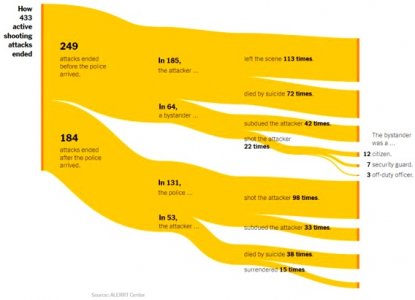You are using an out of date browser. It may not display this or other websites correctly.
You should upgrade or use an alternative browser.
You should upgrade or use an alternative browser.
U.S. Supreme Court Upholds the 2nd Amendment
- Thread starter oldman
- Start date
Lethe200
Senior Member
- Location
- San Francisco Bay Area
Who Stops a ‘Bad Guy With a Gun’?
Washington Post June 22, 2022
The lengthy police response to a school shooting in Uvalde, Texas, and the death of an armed security guard as part of an attack on a Buffalo supermarket last month have drawn fresh scrutiny to a recurring (and uniquely American) debate: What role should the police and bystanders play in active shooter attacks, and what interventions would best stop the violence?
The debate has moved to Capitol Hill as lawmakers consider gun safety legislation that could increase funding for mental health services, school safety and other measures aimed at keeping guns out of the hands of dangerous people. “What stops armed bad guys is armed good guys,” Senator Ted Cruz suggested in the wake of the Uvalde shooting, echoing many other gun rights advocates over the years.
Researchers who study active shooter events say it can be difficult to draw broad policy conclusions from individual episodes, but a review of data from two decades of such attacks reveals patterns in how they unfold, and how hard they are to stop once they have begun.
There were at least 433 active shooter attacks — in which one or more shooters killed or attempted to kill multiple unrelated people in a populated place — in the United States from 2000 to 2021. The country experienced an average of more than one a week in 2021 alone.
The data comes from the Advanced Law Enforcement Rapid Response Training Center at Texas State University, whose researchers work with the F.B.I. to catalog and examine these attacks. Unlike mass shooting tallies that count a minimum number of people shot or killed, the active attack data includes episodes with fewer casualties, but researchers exclude domestic shootings and gang-related attacks.
Researchers caution that some older attacks may be missing from the data, but they feel confident in their overall assessment that shootings are increasing. What is less clear is how to limit the damage of these attacks, given how quickly they unfold and how powerful the weapons used can be.
Most attacks captured in the data were already over before law enforcement arrived. People at the scene did intervene, sometimes shooting the attackers, but typically physically subduing them. But in about half of all cases, the attackers committed suicide or simply stopped shooting and fled.
“It’s direct, indisputable, empirical evidence that this kind of common claim that ‘the only thing that stops a bad guy with the gun is a good guy with the gun’ is wrong,” said Adam Lankford, a professor at the University of Alabama, who has studied mass shootings for more than a decade. “It’s demonstrably false, because often they are stopping themselves.”

Washington Post June 22, 2022
The lengthy police response to a school shooting in Uvalde, Texas, and the death of an armed security guard as part of an attack on a Buffalo supermarket last month have drawn fresh scrutiny to a recurring (and uniquely American) debate: What role should the police and bystanders play in active shooter attacks, and what interventions would best stop the violence?
The debate has moved to Capitol Hill as lawmakers consider gun safety legislation that could increase funding for mental health services, school safety and other measures aimed at keeping guns out of the hands of dangerous people. “What stops armed bad guys is armed good guys,” Senator Ted Cruz suggested in the wake of the Uvalde shooting, echoing many other gun rights advocates over the years.
Researchers who study active shooter events say it can be difficult to draw broad policy conclusions from individual episodes, but a review of data from two decades of such attacks reveals patterns in how they unfold, and how hard they are to stop once they have begun.
There were at least 433 active shooter attacks — in which one or more shooters killed or attempted to kill multiple unrelated people in a populated place — in the United States from 2000 to 2021. The country experienced an average of more than one a week in 2021 alone.
The data comes from the Advanced Law Enforcement Rapid Response Training Center at Texas State University, whose researchers work with the F.B.I. to catalog and examine these attacks. Unlike mass shooting tallies that count a minimum number of people shot or killed, the active attack data includes episodes with fewer casualties, but researchers exclude domestic shootings and gang-related attacks.
Researchers caution that some older attacks may be missing from the data, but they feel confident in their overall assessment that shootings are increasing. What is less clear is how to limit the damage of these attacks, given how quickly they unfold and how powerful the weapons used can be.
Most attacks captured in the data were already over before law enforcement arrived. People at the scene did intervene, sometimes shooting the attackers, but typically physically subduing them. But in about half of all cases, the attackers committed suicide or simply stopped shooting and fled.
“It’s direct, indisputable, empirical evidence that this kind of common claim that ‘the only thing that stops a bad guy with the gun is a good guy with the gun’ is wrong,” said Adam Lankford, a professor at the University of Alabama, who has studied mass shootings for more than a decade. “It’s demonstrably false, because often they are stopping themselves.”

Been There
Well-known Member
- Location
- Florida
It's unlikely that mass murderers carry a permit.

